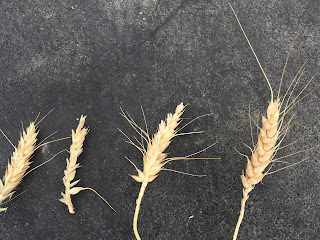Harvest is upon us and we have had two inquiries about our Shelbourne Stripper Head, so I'm making a post about it. For more head detail visit the following link. Stripper Header
Does a stripper head have a future in your operation? That will depend on what you want to accomplish.
PRO's: --tall stubble is great for snow catch. Tall stubble will hold yours in place and catch some of your neighbors passing by. --tall stubble reduces air velocity across the soil surface for potential moisture savings by reducing the replacement frequency of the surface boundary layer. --there is a significant reduction of material that the combine has to process resulting in less overall machine wear. --there is a significant reduction in dust at the throat of the feeder house resulting in better operator vision in the evenings with calm conditions. --generally there is an increased speed of harvesting. --generally, heavy single disc drills work better because there is less residue laying on the soil surface. --if you intend to remove the straw, stripper headed stubble is great for swathing and baling.
CON's: --stripper heads can leave the field more challenging to seed. Hoe drills will likely be problematic. --stripper heads are less adaptable than a conventional cutter bar head for some crop types (crops with deep podding and crops with fragile seed coats). The adjustable hood over the rotor of the stripper head is restricted to approximately 18"maximum opening for efficient crop intake. An example, winter canola will set pods ~24" down the plant compared to wheat at ~8"-12". --ground hugging crops like lentils subject the rotor to more potential damage from ground strikes. The stripper head rotor will fling rocks long distances with great force. --there is a greater concern of starting a fire from vehicles in tall grain stubble.
NARRATIVE: The Shelbourne Reynolds Company make three models of stripper heads (RX, CVS, RSD) that range from 12' to 42' wide. Our head is a 2012 CVS32. They all require an adaptor plate specific to the type of combine it is being mounted on. We have found that auto tilt and auto height control are good investments to lower crop loss and reduce operator fatigue. Hood position and rotor speed is operator controlled. Correct settings of both are important to minimize crop loss, and may need adjusting to match different field conditions through out the day. Notice that the rotor fingers have an elevated edge forming a cup like shape. When that elevated edge is gone we consider the finger worn out. We change out the fingers more frequent than Reynolds representative's told us. When we inquired about the wear, we were reminded that wear is a function of volume processed. Our crop yields generally are significantly higher than midwestern yields where the data is developed.
The WSU dry land research station at Lind, WA. shows no advantage in moisture saving with the stripper head. This 8"- 12" rainfall site has very little crop residue to work with on light (near powder) soils, exposed to a lot of wind on a relatively flat open landscape. That station is a challenging site, so I'll revise any statement I may have made on earlier posts in this way, --soil surface armor (cover) is very important for moisture savings when compared to bare soil. Any crop residue height that can be developed or maintained beyond soil surface cover will have beneficial effects on saving additional moisture. Thin standing residue with no soil surface cover under it, exposed to blistering sun, will pull moisture fast.

The stripper head excels in small grains (wheat & barley). We have harvested wheat-barley-garbs-spring canola-mustard and dry peas. We currently own a Gleaner S77 and it came with an model 8200 30' auger header with an air assisted reel. We use the 8200 head for dry peas and brassica (mustard and canola) crops. With brassica's, most of the plant is processed, hence we found excess wear on the rotor fingers compared to small grains. Although stripper head loss is low when harvesting brassica's, loss was still approximately twice that of the 8200 air assisted head. We had excessive seed coat damage when harvesting dry peas. That may have been do to bad rotor speed adjustment, but the Gleaner 8200 head also has a floating cutter bar for closer cut to the ground, along with deep flighting on a full fingered auger to mover bulky crop material to the feeder house. We have never harvested lodged wheat that hugs the ground. We are told that it will recover that type of lodged grain very well.

Stubble can end up taller than the crop after harvesting grain with heavy seed heads . We mostly notice this phenomena with barley where heads with heavy grain pop up when the grain is removed. I don't recommend leaving a patch of unharvested crop in the field unless you have the capability of machine mapping to show where you have cut, and where you haven't.
A sign of a farmer with a stripper head. Avoid going into stripper headed fields when conditions are conducive for fire.
At the right side of the blog click on "stripper head" under "label". This brings up all postings on the Shelbourne Reynolds Stripper Header that I have made over the years.
Below are two videos from 2019 showing the Shelbourne stripper head and the AGCO 8200 harvesting canola. These videos wouldn't play on the 2019 posting and I tried to update, and I think I have botched the whole posting, and maybe more.






